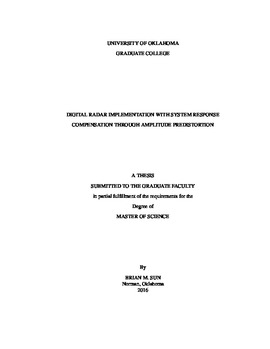| dc.description.abstract | Radars traditionally synthesize waveforms by using a variety of analog electronics. These analog components are collectively referred to as the analog chain. A typical electronic analog chain contains multiple components, such as frequency mixers, signal generators and local oscillators. The analog chains are typically used in radars for both the transmit and receive circuits. This design generally causes radars to be unnecessarily bulky and power intensive.
However, with modern advancements in digital electronics, waveforms can more easily be synthesized and captured using only digital electronics. Digital electronics require significantly less power and occupy less space. The synthesis of radar waveforms using only digital electronics, such as Digital-to-Analog Converters (DACs) and Analog-to-Digital Converters (ADCs), allows for a majority of the analog chain to be removed from the system. A single digital component requires less power and provides more capability, thus providing a better alternative to the typical analog chain. In addition, digital signal processing techniques can still be used to increase the efficiency of the radar system. For instance, the received signal can be under sampled to reduce the amount of data collected by the radar.
The effects of the system response cause the amplitude modulus of the waveform to be inconsistent, which effectively causes fluctuations in the power transmitted by the radar. Having a radar waveform with fluctuations in transmitted power is not ideal since the range of the radar is a function of the power transmitted. When implementing pulse compression signal processing, a waveform with a fluctuating modulus reduces the signal-to-noise ratio returned from the matched filter. In applications like Synthetic Aperture Radar (SAR), having a high signal-to-noise ratio is crucial to creating an accurate image. In order to create a constant amplitude waveform, the amplitude distortions must be compensated for. The method utilized here to compensate for the amplitude distortions is to predistort the waveform. When the predistorted waveform is influenced by the system, the output waveform has a near constant amplitude modulus. | en_US |
